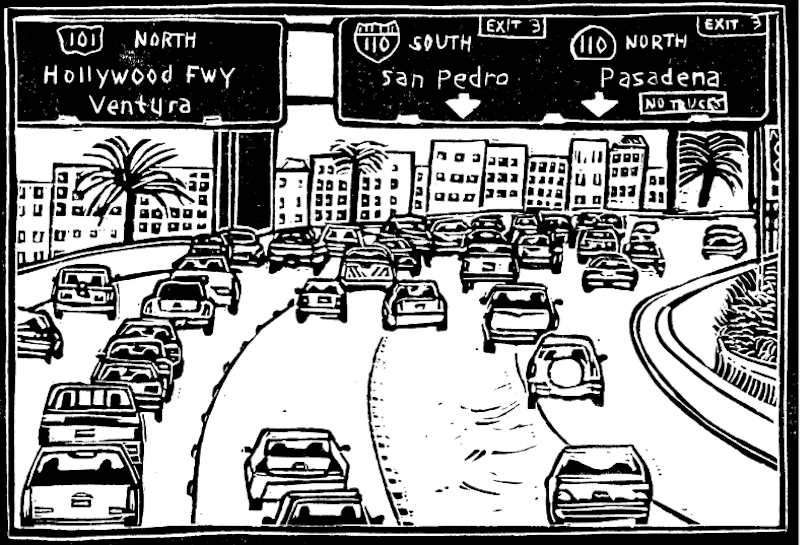Recently, I had a flat tire on the 405 Freeway. I pulled to the right shoulder and called Auto Club. I was told there was a two-hour delay and was advised to wait in the car. I didn’t. Even though it was raining, I exited the car and leaned against the freeway wall while commuters sped by at 80 mph. One truck came so close, my Mazda wobbled back and forth from the wind vortex. When the tow truck finally arrived, it parked at an angle 20 feet behind my car, its rear bumper jutting into the slow lane. The driver told me he used his truck as a shield in case some drunk or distracted motorist drifted onto the shoulder. “I‘m violating company policy,” he said, “but I don’t plan on dying out here.”
Freeway driving is serious business. Many driving aphorisms simply don’t apply. Defensive driving, for example. You need to be wary and anticipate unpredictable behavior, but it’s just as important to be offensive. If you’re driving at the speed limit while everyone else is speeding, you’re a problem. Other drivers will tailgate, honk, cut you off and flip you the finger for driving too slow. To road-ragers, slow drivers are raw meat.
When changing lanes, we’re taught to use our turn signal, wait for a clear space, then move into the next lane. In reality, this is the worst thing to do. The moment you hit your blinker, cars speed up so you can’t cut in front of them. Entitlement reigns on freeways and lane changes trigger other drivers. The best way to shift lanes is cut into the adjacent lane and then hit the blinker.
When someone rides your bumper at high speed, they’re playing bully ball. This is the number one cause of freeway accidents, people tailgating while speeding. When someone tailgates me, I slow down. If you linger at the speed limit, the tailgater will ultimately go around you.
I avoid driving behind pickup trucks with open beds particularly when they’re hauling equipment. Gardeners in pickups are awful. They’re always in a rush from job to job and they don’t secure their supplies properly. My car was once struck by a flying paint bucket. Another time I barely dodged a wayward trashcan. Gravel trucks are the worst. Years ago, my windshield was shattered from a flying piece of gravel. If you find yourself in an agricultural area, avoid trucks hauling produce. It’s no fun getting struck by a flying tomato.
Keep at least one lane between your car and big rigs, especially on windy days. Truck drivers are wild cards. They’re not supposed to work longer than 14 hour shifts but few observe this rule. When I see a weaving big rig, I back off until their driving returns to normal. The scariest trucks are fuel trucks. Even before I saw Mad Max and Terminator, I gauged these vehicles as roving explosive devices. I avoid them.
The biggest a-holes on the road used to be Mercedes and BMW drivers. These days it’s Tesla drivers. Teslas are so expensive their owners feel like they have a greater right to freeway access than those in plebeian cars. Teslas have amazing pickup tempting drivers to make brash lane changes. I’ve had more near misses with Elon Musk’s minions than any other car on the road.
It’s good to avoid cars with dents, scratches, wonky paint jobs and missing bumpers. These drivers have been in prior accidents and haven’t bothered repairing the damage, probably for financial reasons. This means they likely don’t have insurance and are prime candidates for hit and run drivers.
During a rainstorm, I avoid the slow and fast lanes. Most freeways are beveled allowing rain to flow to the storm drains on the edges. Slow and fast lanes accumulate the most water. Driving through a puddle at high speed can cause tires to hydroplane and the driver to lose control. I find the safest lane in the rain as the second from the right.
Living in Los Angeles, I witnessed one police chase. The perpetrator came upon me at more than 100 mph followed by several speeding cop cars. It happened so fast I had no time to react. The felon cut onto the shoulder to pass freeway traffic. Had I followed my inclination and pulled over to the side, I would’ve been rear-ended. The chase came to an end when the driver slammed into several cars ahead of me.
When asked what they look for when issuing speeding tickets, the highway patrol cites unsafe driving as much as speed. California has a Basic Speed Rule. “No person shall drive a vehicle upon a highway at a speed greater than is reasonable or prudent having due regard for weather, visibility, the traffic and the surface and width of the highway, and in no event at a speed which endangers the safety of persons or property.” This means drivers can be cited for speeding even when driving below the speed limit if it’s deemed unsafe (during a rainstorm, for example). Truckers use an adage when deciding how far over the speed limit to drive. Five you’re fine, nine you’re mine.
Some freeway tips are obvious. Don’t drink, smoke weed, text, hold a cell phone to your ear. Others are more obscure. A policeman on a film set once told me that cars with bumper stickers and vanity license plates have more accidents than those without them. He theorized this is because people drive too close to read bumper stickers causing rear-end collisions.
I’ve found the best freeway tip is to “be predictable.” Most collisions occur when a driver does something unexpected. It’s important to use common sense, intuition and precognition (predicting bad maneuvers). Of course, once the self-driving cars hit the freeways, all bets are off. I’m wondering if Waymo will be coded for road rage.

